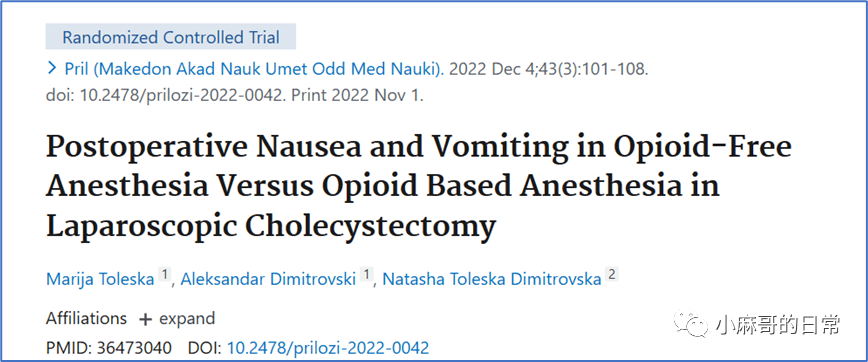作者:米勒之声

摘要译文
腹腔镜胆囊切除术中无阿片麻醉与有阿片麻醉的术后恶心呕吐
背景:
术后恶心呕吐(PONV)是腹腔镜胆囊切除术患者常见的并发症。
由于术中减少阿片类药物的使用已被证明对患者术后恢复有更好的效果。
在本研究中,我们评估了无阿片类药物麻醉对腹腔镜胆囊切除术后恶心和呕吐的影响。
材料和方法:
80名20-65岁的患者被纳入这项随机、临床和前瞻性试验。 患者属于ASA 1级和2级,择期进行腹腔镜胆囊切除术。 患者分为两组: 第一组(芬太尼组-FG),包括40名接受阿片类药物麻醉的患者; 第二组(无阿片类麻醉组OFAG),包括30名接受无阿片麻醉的患者。 在第1组(芬太尼组-FG)患者中,全身麻醉诱导包括给予: 0.04mg/kg的咪唑安定、 0.002mg/kg的芬太尼、 2mg/kg的异丙酚、 0.6mg/kg的罗库溴铵。 这些患者在手术期间接受了分次推注芬太尼。 全麻前,这些患者未接受地塞米松。 第2组(无阿片类药物麻醉组-OFAG)的患者 在麻醉前接受0.1 mg/kg地塞米松和1 g扑热息痛作为预先镇痛。 麻醉诱导包括给予 0.04mg/kg的咪唑安定、 1mg/kg的利多卡因、 2mg/kg的异丙酚、 0.5mg/kg的氯胺酮、 0.6mg/kg的罗库溴铵。 插管后立即持续静脉输注利多卡因(2mg/kg/h)和硫酸镁(1.5g/h)。 在该组中,无论是在麻醉诱导期间还是在术中,均未给予芬太尼。 第2组(OFAG)胆囊取出后立即静脉注射2.5克安乃近。 术后24小时记录PONV。
结果:
年龄、体重、性别、手术时间和麻醉时间无显著差异。
与无阿片类麻醉组相比,芬太尼组在术后1小时、4小时、8小时、12小时和24小时的所有术后时间点,不同时间间隔的PONV均无统计学意义。
即使没有统计学意义,PONV在接受阿片类麻醉的患者中发生的频率也更高。
结论:
在腹腔镜胆囊切除术中接受阿片类药物的患者与接受无阿片类麻醉的患者相比,术后恶心和呕吐的发生率更高,但无统计学意义。
关键词:
腹腔镜胆囊切除术;有阿片麻醉;无阿片物麻醉;术后恶心和呕吐。
原文摘要
Postoperative Nausea and Vomiting in Opioid-Free Anesthesia Versus Opioid Based Anesthesia in Laparoscopic Cholecystectomy
Background:
Postoperative nausea and vomiting (PONV) is a usual complication in patients undergoing laparoscopic cholecystectomy. Minimized opioid use due to surgery has been shown to have a better effect on patient recovery after surgery. In this study we evaluate the effect of opioid free anesthesia for postoperative nausea and vomiting in laparoscopic cholecystectomy.
Materials and methods:
80 patients aged 20-65 years old were included in this randomized, clinical and prospective trial. The patients belonged to the ASA classifications 1 and 2 and were scheduled for laparoscopic cholecystectomy. Patients were classified into two groups: group 1 (fentanyl group- FG), which included 40 patients who received opioid anesthesia, and group 2 (opioid free anesthesia group-OFAG) which included 40 patients who received opioid free anesthesia. In patients from group 1 (fentanyl group -FG) introduction to general anesthesia consisted of giving midazolam at 0.04 mg/kg, fentanyl at 0.002 mg/kg, 2 mg/kg of propofol and 0.6 mg/kg of rocuronium bromide. These patients received fractionated bolus doses of fentanyl during surgery. Prior to general anesthesia these patients did not receive dexamethasone. The patients from group 2 (opioid free anesthesia group - OFAG) received dexamethasone at 0.1 mg/kg and 1 g of paracetamol before introduction to anesthesia as a pre-emptive analgesia. Introduction to anesthesia consisted of giving midazolam at 0.04 mg/kg, lidocaine at 1 mg/kg, propofol at 2 mg/kg, ketamine at 0.5 mg/kg, and 0.6 mg/kg of rocuronium bromide. Immediately after intubation, continuous intravenous infusion with lidocaine at 2 mg/kg/h and magnesium sulfate at 1.5 g/h was given. In this group, fentanyl was not given either during the introduction of anesthesia or during the intraoperative period. Immediately after extraction of the gallbladder patients from group 2 (OFAG) received 2.5 g of metamizole intravenously. PONV were recorded in the postoperative period of 24 hours after surgery.
Results:
There was no significant difference with respect to age, weight, sex, duration of surgery, and anesthesia time. PONV at different time intervals were statistically not significant at all postoperative time points - 1 hr, 4 hr, 8 hr, 12 hr and 24 hr after surgery in fentanyl group compared to opioid free anesthesia group. Even not statistically significant, PONV have occurred more often in patients who received opioid anesthesia.
Conclusion: Postoperative nausea and vomiting occurs more often in patients who received opioids during laparoscopic cholecystectomy compared to patients who received opioid free anesthesia, but without statistical significance.
Keywords:laparoscopic cholecystectomy; opioid based anesthesia; opioid free anesthesia; postoperative nausea and vomiting.
免责声明:
本微信公众平台所刊载原创或转载内容不代表米勒之声的观点或立场。文中所涉及药物使用、疾病诊疗等内容仅供医学专业人士参考。
—END—
编辑:Michel.米萱
校对:MiLu.米鹭
本文转载自其他网站,不代表健康界观点和立场。如有内容和图片的著作权异议,请及时联系我们(邮箱:guikequan@hmkx.cn)
本文来自投稿,不代表长河网立场,转载请注明出处: http://www.changhe99.com/a/za6lZ5NWwm.html

